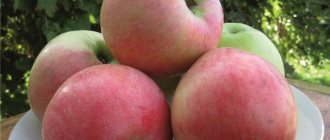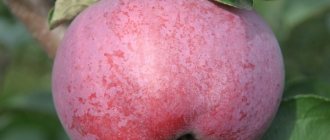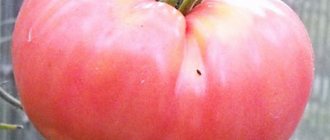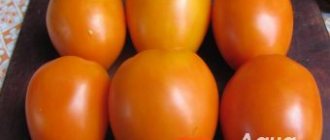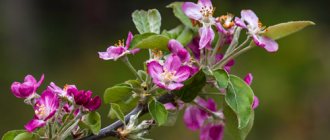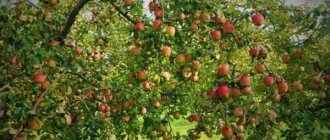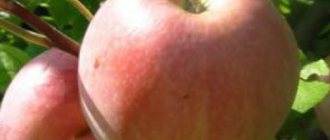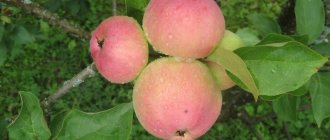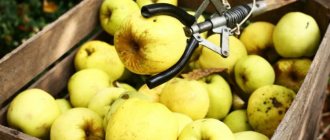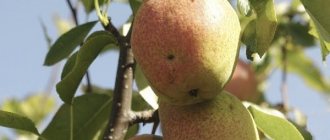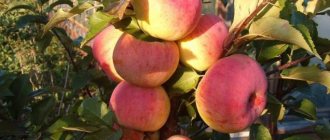Planting and care
When planting a tree, classic fertilizers are used. The apple tree is not fussy to care for.
Amazing - late winter apple tree variety.
IMPORTANT: When planting, avoid places where groundwater is located close to the surface. Otherwise, the seedling will end up in the water and the tree will rot. Planting of this variety is advisable in one of two periods: spring (late April) and autumn (late September - early October)
Planting of this variety is desirable in one of two periods: spring (late April) and autumn (late September - early October).
However, for this variety, autumn is still recommended.
It is better to purchase seedlings with a developed root system.
Choose well-drained areas for planting this variety.
It is recommended to use loam soil so that the tree grows strong and produces maximum yield.
It is better to plant trees at a distance of 2.5 m. Be sure to water the tree abundantly immediately after planting.
TIP: If it is not possible to obtain such soil, you can dig a hole one meter deep and a diameter, cover it with layers of sand, compost and peat chips. This will create even better conditions for seedling germination.
The next year after planting, in the spring, it is important to shape the deciduous crown of the apple tree. You need to cut off the ends of each branch.
And during the first four to five years, do not allow the apple tree to form fruits.
You need to trim the ends of each branch. And during the first four to five years, do not allow the apple tree to form fruits.
If the soil is fertile, then the apple tree of the “Amazing” variety practically does not need additional fertilizer. Feeding it once a year will be enough.
For this it is better to use:
- manure humus;
- mixture of microelements (N,Se,B,P);
- 0.5% urea;
- calcium salts.
In April, it is imperative to irrigate trees with mixtures that protect against pests.
This procedure should be carried out twice: when the buds on the branches begin to swell and before the buds bloom.
Then the tree no longer needs to be fertilized throughout the year. The Amazing apple tree variety does not really need water. Therefore, it is advisable not to carry out excessive watering.
Care
Winter Beauty needs feeding in spring and autumn with various complex fertilizers without nitrogen. If the soil is rich in nutrients, then frequent feeding is not needed.
If the soil is sandy, fertilizers are required every year. In the first year after planting, 80-100% of the flowers should be cut off. This is required to improve the survival rate of the tree.
Next, you need to pick off half of the still green crop (only the established fruits). Watering is done 4-5 times a month at the rate of 1 bucket of water per 1 adult tree, 2 times a day.
It is important to ensure good watering in July-August. Watering should be stopped in August, otherwise the shoots will grow protractedly, which will have a bad effect on winter hardiness.
This apple tree is resistant to frost, but to save the plant from early frosts and snowless winters, you should mulch it with horse humus near the tree trunk, wrap the trunk with special covering materials or nylon tights.
To combat hares and mice, use nylon tights or a special rodent net.
The following varieties can also boast resistance to frost: Arkadik, Aport blood-red, Lada, Yubilei Moskvy and Moskovskaya late.
It is important to remember the contents of the tree trunk circle. No plants should grow in it; it must be cleared of weeds and loosened.
In the spring after planting, it is important to treat the tree bark with a lime mixture, which will repel pests. After the first leaves appear, the crown is actively treated for scab.
After the ovaries of inflorescences appear, the tree is treated with insect repellents. Regular processing is required even after the appearance of the first fruits.
Graft
Used for propagation of the variety. In the spring, when the buds bloom in twos, an apple tree cutting is grafted onto a branch under the bark. The main branch should be quite strong and located at a high level from the ground.
Pruning and crown formation
Pruning to form the crown is carried out annually in early spring. Only straight, strong branches are left, the rest are removed as much as possible at the base of the tree.
Apple tree Winter Beauty
We chose seedlings of this variety because the variety is not afraid of frost. Here in the Moscow region it can be above 30, but for 6 years now they have been wintering safely. In dry years, you have to water them from early spring and early summer, when the ovary appears. If this is not done, the ovary may crumble. The crown should begin to form from the 2nd year after planting. For the winter, it is better to carefully hide the trunks from hares - otherwise they will gnaw off all the bark. Trees must be treated for scab. We harvest at the end of September. We monitor how the apples ripen. If you are late with collection, they may crumble. We always apply fertilizer in late autumn to improve the harvest for next year. Our trees started bearing fruit in the 3rd year. We are not yet harvesting the most abundant harvests. Although the apples themselves are large and dense. They lie at a constant temperature until the beginning of spring normally, then they begin to actively deteriorate.
The apple variety got its name due to its long storage period relative to others. They retain their presentation and taste for about 4-5 months, this is a record among all varieties known to me. The fruits ripen on the tree until green with light pink barrels and taste quite pleasant.
Still, the main advantage of the variety is that it stays fresh for more than 4 months, so I don’t store these apples for future use; you can eat them fresh until the new year. Apples tend to dry out over time. The original size of a fresh apple will not remain in this form for long; over time they become smaller. Shelf life does not affect the taste in any way. The tree is quite fastidious to care for.
The Winter Beauty apple tree is incredibly beautiful, attractive, with amazing nutritional and vitamin properties, it can provide vitamins throughout the entire winter season. Easy to care for and easy to harvest. The tree is approximately 17 years old. The apples are aesthetic in appearance, chiseled, regular and symmetrical in shape, the weight of each apple is approximately 127 grams, elongated towards the bottom.
Storage features: apples are stored for 4-6 months, which is a very long time for natural apples from your own garden; the cooler the storage area, the longer the period before rotting. Amazing keeping quality and storage of fruits. Initially they are dense, green in color, and then become softer and turn yellow, reaching a sweeter taste on the windowsill. They can be boiled for baby food, or peeled and blended - no sugar required. Apples are quite sweet. I grow my natural products in the Tomsk region in the village of Topalevka.
The Winter Beauty apple tree is not at all what summer residents praise it. Winter Beauty for me is an autumn rotten thing, this is the only way to describe its external properties. Sufficient watering, light, fertilizers, but apples are not stored well. I wanted to harvest a decent harvest and eat my pies all winter (the description describes storing apples for up to 4 months at a temperature of -20 +18), but it didn’t work out. I don't understand why apples start to spoil right on the branch. Neither mice, nor hedgehogs, nor hares gnaw the bark, the tree has no scab or other diseases, it grows in the sun, but there is no return.
The Winter Beauty apple tree is a wonderful Russian apple tree and, like everything, it has its pros and cons. Pros: 1. Excellent taste, sweetness with slight sourness; 2. Simple care in the form of watering and thinning of branches; 3. Long-term storage of fruits up to six months; 4. Aesthetic appearance of apples, without wormholes, rottenness, darkening and mold; 5. Universal use for workpieces. Cons: 1. The scourge of the garden can be an influx of rodents - those who like to feast on bark; You can make protective bollards and warm fabric wrapping. 2. Under good conditions, the tree increases in size every year, shading other plantings, making adjustments to the garden plan - our middle and lower branches have completely piled onto the path leading to the end of the site, now we are going around. The branches are long and heavy, and it’s a shame to trim them; you need to take care of this in early spring.
Bottom line: You need to work hard on the apple tree; with proper care, the harvest will be abundant and of high quality. Over time, the fruits tend to decrease in size, but this does not affect the taste in any way.
fruit treesgardengardening
Reviews
Georgy, 66 years old, Krasnogorsk: “There are several winter varieties on my site, among them the Winter Beauty apple tree. We eat the apples fresh and store them in the refrigerator until March. They turn yellow with red stripes and are very sweet and juicy. Caring for the tree is not difficult, I fertilize and prune it every year.”
Ksenia, 50 years old, Samara region: “The Winter Beauty variety has been bearing fruit for me for a long time. Apples are very sweet and beautiful, I make jam and juice from them. The harvest is produced annually, the fruits are medium and large, depending on the number of ovaries, although I pick them off. The tree tolerates winter well and practically does not get sick.”
general characteristics
Only in this case are these fruit trees able to produce a decent harvest in a prolonged cold climate.
For both Western and Eastern Siberia, this fruit crop must have certain characteristics and requirements.
Such as:
- Winter hardiness - resistance to prolonged frosts. There are species with average and increased winter hardiness, capable of withstanding frosts above 40° C. They do not require large amounts of sun and moisture;
- Productivity and precocity. Nobody wants to grow apples with low fruiting or wait 5–6 years for the first fruits to appear;
- Terms of ripening. For such a cold climate, ripening should end before the first frost;
- Plant resistance to all kinds of diseases. The main ones are scab, rot and fungal diseases of the apple tree. We cannot exclude all kinds of pests who want to feast on the leaves, bark and fruits of the tree;
- Taste characteristics. Every gardener dreams of sweet or slightly sour fruits. Everyone wants juicy and flavorful apples;
- Harvest storage. The later the ripening period, the longer the storage.
Important! When planting a new variety, know all its characteristics and the recommendations of experienced gardeners on the conditions for its cultivation. This is the only way to decide which varieties of apple trees are best for your garden.
Characteristics of the variety
The Moscow Beauty apple tree variety has not yet been included in the State Register of apple varieties approved for use, because has not yet been tested at variety plots in different regions. Moreover, it can be found in many private gardens in the Central region and beyond.
Advantages and disadvantages
Like any cultivated representative of fruit trees, Beauty Moscow has its advantages and disadvantages. Among the advantages, gardeners note the following qualities:
- excellent frost resistance;
- very wide angle of regrowth of skeletal branches;
- high productivity;
- very good apple taste;
- presentable appearance, transportability of fruits.
Disadvantages include:
- weak resistance to scab and other fungal infections;
- The shelf life of fruits is short for winter varieties (80 days).
Sizes of an adult tree and annual growth
The tree is of medium size, height in the range of 4-5 m. Annual growth ranges from 30 to 70 cm. With increasing age, the growth rate decreases.
Apple tree Beauty of Moscow.
Productivity and frequency of fruiting
The yield of an adult tree reaches 150 kg. It begins to bear fruit 5-6 years after planting. No sharp frequency of fruiting was recorded; there was a slight difference in the volume of harvests.
Tasting assessment
The pulp is very juicy, sourish-sweet with an exquisite aroma. Deserves a tasting score of 4.5-4.8 points.
Winter hardiness and disease resistance
The apple tree variety is winter-hardy, but Beauty of Moscow does not have very good resistance to fungal infections.
History of appearance
The hybrid owes its appearance to breeder Evgeny Kamendrovsky. The agronomist decided to cross two fruit varieties: Red Delicious and Antonovka Ordinary. The result was an apple variety with unique characteristics that has many advantages; no significant disadvantages were found.
In order to distribute this variety of fruit trees among domestic gardeners, the novice breeder had to turn to the famous agronomist Viktor Suslov for help. The latter, in his book “Encyclopedia of the Best Varieties of Fruit Trees,” paid a lot of attention to the hybrid, considering it the best among those available. This ultimately influenced the popularity of the variety.
Important! The hybrid is suitable for cultivation in the Central and North-West regions of the country
History of selection
The Winter Beauty variety is classified as a domestic apple tree. This variety appeared thanks to the efforts of amateur gardener E. M. Kamendrovsky. He received Winter Beauty thanks to the combination of Red Delicious and Antonovka vulgaris.
But the aspiring scientist was unable to independently spread the apple tree among the population, so V.I. Suslov came to his aid. He decided that this was the best variety of apple tree in the world. Suslov was an economist, but this state of affairs did not become an obstacle to finding supporters among breeders. Winter Beauty had to go through such a thorny path before she became known in wide circles of gardeners. The Winter Beauty apple tree variety appealed to many.
The following varieties are also successfully grown in these regions: Orlik, Pepin saffron, Melba's Daughter, Moscow's Anniversary and Marat Busurin.
Harvesting and storage
The harvest of apples of the variety in question begins in early or mid-September, when the fruits reach full ripeness. Unlike some other varieties, Rozhdestvenskoe does not require a long period of aging and can be eaten immediately after harvesting, revealing all its qualities to the maximum.
Read more about how long to keep apples fresh for the winter at home.
For harvesting, choose only a windless day without precipitation, so that all harvested apples are completely dry. You should not tear off the stalks, and before storing them in the cellar, it is better to immediately sort the apples by size and ripeness, removing spoiled or damaged fruits. If possible, cool the apples or try to at least ventilate them in the fresh air, avoiding exposure to moisture: within 2–3 weeks, defective fruits will appear, which should be removed immediately so that the rot does not spread.
For long-term storage, healthy specimens are wrapped in soft paper and, placed in boxes with the stem facing up, taken to storage at a temperature within +1...+2°C. These are the values that are considered ideal for the comfortable location of Rozhdestvenskoe apples and the long-term preservation of all their properties.
In general, the described variety can be considered as one of the most suitable options for cultivation in most of Russia and neighboring countries: the trees are relatively unpretentious in care and always delight with stable yields of tasty and juicy fruits of universal use.
Advantages and Disadvantages of Culture
Any variety has its advantages and disadvantages. The Winter Beauty hybrid has the following advantages:
- large uniform fruits;
- good tasting score – 4.5 points;
- long shelf life (until the beginning of winter);
- high frost resistance (withstands temperatures down to -34°C);
- good resistance to scab and other diseases.
No significant deficiencies were identified in the culture.
Something to remember! In the absence of proper care, the fruits of the hybrid may become smaller. This is especially true in cases where the tree is not pruned in the spring and the yield on the branches is not rationed.
In order for a good harvest to always please you, you need to carefully fulfill a number of conditions. Firstly, choose the right seedling, secondly, plant it in the ground correctly and on time, thirdly, do not forget to care for it. The algorithm of actions is simple, it will bring tasty and beautiful fruits to a caring gardener.
https://youtube.com/watch?v=Tuj8OkkpiWE
Disease resistance
Winter Beauty has a pronounced immunity to diseases. But this does not mean that you do not need to take care of it. Preventive treatment in spring and autumn is mandatory. Since a cared for plant produces more fruit and rests less.
A popular way to control pests is to whitewash the base of the trunk with lime. Saves from insects and some diseases. In addition, there are other ways of fighting; choosing a convenient one for everyone will not be difficult.
See also
Planting and caring for columnar apple trees in Siberia, cultivation and the best varietiesRead
When using chemicals, do not forget about safety. Apply in early spring or after fruiting. Chemical treatment during flowering is prohibited, since pollinating insects die. And not only in a single copy. Chemicals introduced into the hive kill the entire bee family.
Features of growing and caring for an apple tree
You need to grow an apple tree in loamy soil and with sufficient lighting. Porous, well-drained soil will only benefit the tree. The place for planting can be near fruit-bearing trees; apple trees normally coexist with cherries, sea buckthorn, and ranetka. It is advisable to plant several seedlings at a time. When flowering begins, the tree will need other inflorescences to carry out effective pollination.
It is best to plant an apple tree in dry, cloudy weather in mid or late April. It is believed that this pair is optimal, since the soil has already warmed up sufficiently. It is better to plant an apple tree with two or three people: the seedlings are usually already tall, and it will not be so easy to cope with them alone.
In the right place, dig a hole, place half a bucket of horse manure and humus in it, and also add a tablespoon of superphosphate and ammonium nitrate to the bucket. The seedling is immersed in a hole and covered with earth. There is no need to trample down the soil after planting. Sprinkle the soil with cool water and insert a support as tall as the planted bush. You can tie the bush to a support.
A couple of weeks after planting, the apple tree will get stronger and begin to produce roots.
Important! The apple tree is a crop that takes a long time to grow and develop; it takes years to grow. The harvest is obtained only 3-4 years after planting.
The root system of the apple tree goes deep into the soil
This fact should be taken into account when watering. For watering, use 3-4 buckets of water at a time. The water should be slightly warm, but not icy. Cold water increases the risk of root rot. The leaves and trunk of the apple tree can be irrigated with a hose or shower; this will especially have a good effect on the plant in dry summer weather. Although the apple tree loves watering, you should not overdo it. Overmoistening the soil again threatens to rot the root system and will only harm the tree
The root system of the apple tree goes deep into the soil. This fact should be taken into account when watering. For watering, use 3-4 buckets of water at a time. The water should be slightly warm, but not icy. Cold water increases the risk of root rot. The leaves and trunk of the apple tree can be irrigated with a hose or shower; this will especially have a good effect on the plant in dry summer weather. Although the apple tree loves watering, you should not overdo it. Overmoistening the soil again threatens to rot the root system and will only harm the tree.
The use of fertilizers has a good effect on the growth of apple trees. Fertilizing is carried out 3-4 times a year: in spring, summer and autumn. The young tree is fed with nitrogen-containing additives in the spring, and with potassium sulfate in the summer and autumn. It is not necessary to fertilize more than 4 times a year. It must be remembered that an excess of fertilizers in the soil has a detrimental effect on the apple tree and can slow down fruiting. All additives must be diluted according to the manufacturer's recommendations on the packaging.
Many people know that in autumn and spring the lower part of the apple tree needs to be whitened. This is done in order to protect the bark from damage and infection. Whitewashing is carried out until the buds open. In addition to whitewashing, in the spring the soil is irrigated with copper sulfate. Vitriol is also applied to apple tree leaves. It protects the tree from scab, powdery mildew and spotting. The additives Fitoverm, Herold and Aliot are used against insects. They protect the apple tree from butterflies, mites, moths, silkworms and moths.
The first fruiting of the apple tree will be small, over time the number of apples and taste properties will increase. The apples stick well to the branches and do not fall off. The fruits need to be collected when they reach maturity, namely when they are full. The stalk comes off along with the apple.
Attention! Fruits that have already fallen from an apple tree are unsuitable for consumption.
Picked apples can be stored for up to 2 months. You need to store it in the refrigerator or in a cool, dry place, a cellar will do. The main storage condition is the absence of humidity. If the apples begin to become damp, the rotting process spreads very quickly.
In the first years of an apple tree’s life, it is better to cover it for the winter. In the future, when the tree has already become an adult and will bear fruit for several years, it is no longer covered. Cover all apple bushes with nylon tights or agrofibre. It is not necessary to cover tightly, since the apple tree needs fresh air. Usually Winter Beauty tolerates even harsh winters well, so there is no concern for the apple tree.
Aftercare of the tree
Apple tree Cherry
The hybrid does not require special care for itself. The same manipulations are performed on it as on ordinary apple trees, namely:
- Regular watering. It is performed every week with one bucket of water, morning and evening. At the same time, you cannot flood the roots, otherwise they may rot;
- Loosening the soil and removing weeds, which is performed as necessary;
- Feeding. The tree is fertilized every three months: in the spring they use ammonium nitrate (40 grams per 10 liters of water), in the summer - phosphorus-potassium fertilizers (0.3 kg per 1 m²), and in the fall - horse humus (3 kg per 1 m²). If the tree is old, then furrows are made around its trunk, into which fertilizer is poured, and earth is poured on top;
- Apple tree pruning. Performed every year in the spring. The branches are cut by one third, leaving certain buds, and the rest are removed. This is necessary for the correct formation of the crown. It is better to completely remove old branches that are 4-5 years old so that new shoots can appear. The first flowers on the hybrid are completely removed;
- Harvest rationing. It is necessary to ensure that one branch does not bear many fruits, otherwise they will subsequently become smaller.
Important! During flowering and drought periods, the apple tree may need additional watering.
Features of ripening and fruiting
Landing stage
At the first stage, you need to choose the right place to plant the seedling in the ground. It must meet the following requirements:
- good illumination of the area;
- absence of drafts and strong winds;
- groundwater occurrence below 2.5 m.
Timing and scheme
Seedlings of any varieties of apple trees are planted in a permanent place in the spring (before active sap flow begins) or in the fall (before the onset of frost).
Watering the Krasapvitsa Moscow apple tree after planting.
Technology
Any apple tree, including the Beauty of Moscow variety, requires the right approach to the planting process. Compliance with certain rules guarantees the correct development of the young tree, which will have a positive effect on subsequent fruiting:
- A hole with a diameter of 60-70 cm and a depth of 80 cm should be prepared a month before the planned planting. When planting a seedling in autumn, the hole is prepared at the end of summer. If planting is planned for spring, then the hole must be prepared in the fall and left in the winter.
- The soil removed during excavation is divided into two parts: the top layer and fertile soil. The top layer is mixed with mineral fertilizers, humus and wood ash.
- Experienced gardeners recommend placing stones and several very rusty metal objects at the bottom. Stones are needed for drainage, and rusty cans, old unnecessary tools or nails will provide the tree with such important iron for a long time.
- Then a mound of topsoil with fertilizer is laid out at the bottom. A wooden peg is stuck into it, to which a seedling is then tied. Fertile soil is sprinkled on top to avoid direct contact of the roots with fertilizers, which can cause burns to the tender roots.
- The seedling is placed on the top of the mound, straightened and the roots are carefully laid out. After this, the roots are covered with fertile soil mixture and compacted so that there are no air pockets left in the soil. The root collar should remain above the ground at a height of 5-7 cm.
- A near-trunk circle with a diameter of 1 m is formed. The freshly planted tree is watered abundantly and the soil is mulched.
After proper planting, it is necessary to provide no less proper care.
The first year after planting, the seedling does not need additional feeding. It only requires regular watering. When flowering occurs this year, it will be necessary to remove all the flowers to give the seedling the opportunity to take root well. Circumcision, on the contrary, is recommended to be carried out from the first year of planting. This is necessary for the correct formation of the crown.
The process of crown formation in the Beauty of Moscow apple tree variety.
Pollinator varieties
Moscow Beauty is a non-self-pollinating variety, so it requires neighbors - pollinators. Those varieties whose flowering dates coincide with the flowering of Beauty are ideal for this role:
- Anise;
- Bogatyr;
- Moscow winter;
- Welsey.
Beauty of Moscow has some features unique to this variety.
Beginning of fruiting
The period of fruiting is average: when planted as an annual seedling, it begins to bear fruit after an average of 5 years.
Peculiarities
Mostly last year's shoots bear fruit. The fruits are formed mainly at the ends of the branches.
Apples turn red within a few days, almost before harvesting.
Fruit ripening
Fruit ripening period: last ten days of September – mid-October.
Fruits of the Moscow Beauty apple tree.
The harvest begins at the end of September, after the apples have turned red. The shelf life is not typical for winter varieties and is no more than three months.
Jonathan
This late-winter American variety has other names: Winter Red, Winter Khoroshavka, Oslamovskoe. The trees are medium-sized and produce a good harvest only on fertile, sufficiently moist soil. The variety is relatively resistant to powdery mildew and scab. The fruits have excellent taste. By the end of ripening, a red blush covers almost their entire surface.
| Entry into fruiting | Tree height (m) | Fruit weight (g) | Harvest | Shelf life (days) | |
| For 4-5 years | 2,5-3 | 110-150 | Mid September | 150-180 | |
| Entry into fruiting | Tree height (m) | Fruit weight (g) | Harvest | Shelf life (days) | |
| For 4-5 years | 2,5-3 | 110-150 | Mid September | 150-180 | |
Winter apple trees for the Middle Zone
This territory extends from the Leningrad and Volgograd regions in the north to the Saratov and Belgorod regions in the south. In the west it borders with Belarus, and in the east with the Eastern Volga region. Snowy winters with moderate frosts prevail here, summers are warm and humid. This means that when choosing an apple tree, you need to take into account both its winter hardiness and immunity to disease.
Antonovka vulgare
The first mentions date back to 1848. The tree is tall (more than 5 m), the fruits are medium and large - 120 g, some specimens - 300 g. Their shape is very different - flattened, conical, cylindrical. The color is always yellow-green, sometimes a pink or orange blush appears. The taste is good, Antonovka is valued for its high content of vitamin C. The yield is impressive - 200 kg, but not every year.
Antonovka apples on one tree can be cylindrical, round, ribbed and smooth
Antonovka is winter-hardy, it blooms late, which means it suffers less from return frosts than others. This is the most famous, but difficult to grow variety. The fruits become covered with scab spots, suffer greatly from the codling moth, and the large crown requires labor-intensive pruning. According to the description of the variety, the fruits are stored for a maximum of 3 months, but some gardeners have apples until March. The tree will delight you with rich harvests for 30 years or more, but only with skillful and painstaking care.
Memory of Michurin
An ancient, proven variety from the 20s of the last century. It grows as an ordinary tree (5–6 m), bears fruit from the age of five. The fruits are very tasty, you can pour a lot of them - about 80 kg. Each weight is 140 g, they look flattened and have ribbing. The cover color is yellow, the blush is scarlet with streaks. The taste is dessert, refreshing. There is a characteristic apple aroma, the pulp is juicy.
Pamyatya Michurin has brightly colored turnip-like fruits, the yield is up to 80 kg per tree
Memory Michurin is a winter-hardy variety. Does not become covered with scab spots even in damp weather. But owners will have to fight another scourge - powdery mildew. In addition, the crown of this apple tree is drooping, which means that you will have to put supports under the branches hung with fruits. It has a high shelf life - until April.
Oryol partisan
This is a triploid apple tree. Most of the crops in our gardens are diploid, that is, their cells have two different sets of chromosomes: maternal and paternal. As a result of intentional or accidental mutation, plants with three or even four sets of chromosomes appear.
Distinctive features of Oryol Partisan apples: rusty funnel and stripes of beet-colored blush
The Oryol giant apple weighs 200 g. The fruits are one-dimensional, round, decorated with a beetroot blush with frequent light dots and stripes. The taste is classic - sweet with sourness and a faint aroma. Among the advantages: fruiting without periodicity, winter hardiness and the already mentioned immunity to diseases. The tree grows quickly. Only the crown gives rise to criticism - it is drooping, the branches bend to the ground from overload. Supports are needed. The harvest is harvested in October and stored until January.
The president
Why not place the President in your garden? The height does not exceed two meters, the results are visible immediately. Already in the first summer after planting there will be several flowers and fruits. You will not be required to grow a tall and powerful tree for five years. This is a variety of columnar apple tree with turnip-shaped fruits of huge size - up to 300 g. The apples are painted in strict colors: yellow-green with a subtle blush. The taste is pleasant, juicy, the flesh is chipping, juicy, there is a subtle aroma.
President apple trees look stylish, are expensive, and delight owners with huge fruits (300 g)
But for early pregnancy and compactness you will have to pay in rubles. One dwarf tree produces a maximum of 10–16 kg of apples; you need to plant several. Productivity lasts 10–15 years, and then new trees will be required. The president is early in winter, the fruit will remain fresh until the New Year.
Pros and cons according to reviews from amateur gardeners
This variety boasts fruit sizes. Their size qualifies as larger than average, large.
One apple can reach 200 g. With proper care, one fruit can reach 400 g.
This variety is often used for making jam and jam , apple wine (cider). All this is thanks to its exceptional taste. The main advantages, according to summer residents and gardeners, are the following description of this variety:
- large and juicy apples, which is rare for winter varieties;
- mature trees tolerate severe frosts;
- fruits are used for preservation and making wine;
- depending on care and feeding, the variety has a wide flavor spectrum;
- The fruits have a beautiful appearance.
The following varieties are also used to make jams and cider: Papirovka, Orlovim, Zolotoe Letnee, Anis.
These are the positive reviews about this variety from experienced gardeners. The only drawback they noticed was in terms of storage. Although it is a winter variety, the fruits of Winter Beauty do not store very well. In wooden boxes and in dry rooms, apples can last until January.
After this, dry rot forms on the peel, completely spoiling the fruit. Because of this, apples are stored in the freezer, where they can remain until March-April.
Description of the Christmas apple tree
The Rozhdestvenskoye apple tree entered the State Register of the Russian Federation only in 2001, but was removed several years earlier. The authorship of the new variety belongs to the breeders of the All-Russian Research Institute of Plant Culture, which is one of the oldest institutes in the country with a large gene pool. The parent apple trees in this case were the Wesley variety and the hybrid form BM 41497, from which the described plant received all its best qualities.
Did you know? You can determine the quality of an apple by the darkening of its pulp. Good fruits, without pesticides, always turn black quickly after being cut, so if you leave parts of the fruit on the plate, you will very soon learn about its true benefits.
Apple trees of this variety are fast-growing plants, which during the first years of cultivation give an increase of 40–70 cm annually. At the age of three years, trees can reach 3–4 m, continuing to grow, but much more slowly. Ten-year-old and older specimens usually do not exceed 5 m in height. The crown is strong, wide-pyramidal in shape, with medium foliage of shoots.
The skeletal branches are strong, grow at an angle of 80° and are covered with gray rough skin. The remaining shoots are also thickened, brown in color, with weak pubescence and a slightly rounded cross-section. The buds that form on them are always conical in shape, well pressed to the branches. The green and matte leaf blades are ovoid, with slight wavy edges. The surface may be slightly wrinkled and has a ridge.
You can harvest apples already in mid-September, and these will be rounded fruits with dense, medium-thick glossy skin weighing 150–200 g. During the flowering of the plant, large umbrella-type inflorescences are formed on the shoots, which consist of 4–6 pale pink petals. To achieve maximum tree productivity, you will have to plant representatives of other varieties next to them, the most suitable of which will be Melba, Antonovka, Papirovka apple trees. Without pollinators, you can hope for the formation of ovaries on no more than 5% of flowers.
The main color is yellow-green, but on top of it is a blurry red blush that runs along the entire circumference. The stalk is thin and long, located slightly at an angle. Under the protective covering layer lies a sweet and sour dense pulp of white-cream color, with a pronounced aroma. Inside it are medium-sized brown ovoid seeds. The average sugar content of fruits is 10.4%. The Rozhdestvenskoye variety is zoned in the Central Black Earth and Central regions of the Russian Federation, but it is often grown in other areas.
Important! To extend the shelf life of the fruits, it is worth using paper to wrap each of them when putting them in a box.
Characteristic
To learn more about the variety, you should study the detailed description. This will help to prevent mistakes during cultivation, while obtaining the declared harvest from Winter Beauty.
Productivity
One tree, with proper care, can produce 150 kg of fruit. Apples are regular in shape, round. Very tasty, sweet and sour. The main color is yellow-green, but the top of the fruit is covered with an uneven ruby tint. One apple weighs 160-200 g. Higher figures have also been recorded, the weight of one fruit reaches 400 g.
Tree height
The plant is medium-sized, so it reaches an average height of 6 m. Tree formation is required, especially in the initial stages. Immediately after planting, the seedling is shortened by 1/3. This way, crown formation will begin faster.
Every year it is recommended to thin out the branches; this will increase the yield due to greater access of oxygen and sunlight to the fruits.
Then the lower branches are removed; subsequently they will bend and make it difficult to approach the tree.
Crown width
Its shape is round-conical. Since the main branches that form the skeleton of the tree are formed at a 60⁰ angle, its width is approximately 3.5-4.5 meters.
Characteristics of apple hybrid
Apple tree Beauty of Moscow
Apple tree Russian Beauty is the second name of the fruit that can be found among agronomists. What did the variety do to deserve such a flattering name? Of course, the correct geometric shape of the fruit. Elongated conical apples are medium or large in size, and the chemical composition consists entirely of useful substances and vitamins.
The weight of one fruit can be 170-200 grams or more. In very rare cases, specimens weighing up to 0.4 kg are found. The apples are yellow-green in color with a bright purple blush. Subcutaneous points are not noticeable. The skin is smooth and pleasantly oily to the touch.
The snow-white pulp of the fruit has a fine-grained consistency. Density is average. Apples contain a lot of juice. The straight stalk has the usual dimensions. The taste is sweet and sour, the expert rating is 4.5 points. The apple aroma is moderate.
Apple tree Winter Beauty (fruit appearance)
The Beauty apple tree is medium-sized, grows up to 6 meters. The crown is spreading, conically round in shape. The skeletal main branches grow to the trunk at an angle of 60°, appearing bare. Foliage density is moderate.
The hybrid is characterized by precociousness. The first apples can be obtained already 5 years after planting. The yield is abundant - up to 150 kg can be obtained from one tree. This variety belongs to the late winter varieties of apple trees. The first harvest is harvested at the end of September. Moreover, it can lie until the beginning of winter, and in the freezer until the beginning of spring.
Description of the Winter Beauty apple tree can be supplemented with a frost-resistant character. The tree can withstand cold temperatures down to -34°C, which makes it able to survive wintering in the Northern region of the country. Gardeners describe the apple tree as an unpretentious tree.
Diseases and pests
A young tree can be seriously harmed by caterpillars and weevils that eat the tender leaves. They must be collected by hand and destroyed mercilessly.
If you plant umbrella crops, for example, dill, between rows, then ichneumon wasps will appear, destroying many sucking and gnawing insects.
When aphids appear (the leaves of the tops curl), the shoots are immersed in water with laundry soap (70 g per bucket).
Preventive measures against fruit sapwood, codling moth, codling moth, hawthorn and silkworms will also not hurt.
Spraying with insecticides and systemic drugs brings positive results:
- Insegarom - against leaf rollers and codling moths;
- Zeon - safe for bees;
- Aktarom - against several types of pests;
- Karbofos (can be used before flowering, after flowering, a month before harvest);
- Trichloride - 5 against several types of pests;
- Benzophosphate (valid for more than a month) - safe for bees.
Powdery mildew affects all plant organs. At first it appears in the form of a gray coating, subsequently turning brown and the appearance of black dots-spores.
The leaf turns yellow, the color dries up, the fruit does not set, and shoot growth stops.
To combat this fungal disease, apple trees are sprayed on young leaves with Topaz or Skor.
After flowering and harvesting, treatment is carried out with copper oxychloride or Bordeaux mixture. Fallen leaves are burned.
Bacterial burn appears at the turn of June-July. Annual growths dry out and the leaves turn black.
The tree dies within two years. This most dangerous viral infection is transmitted through neighboring cuttings and seedlings, and is carried by pests.
Of the control measures, only prevention is known:
- Disinfection of garden tools,
- Treatment of the tree trunk circle with copper sulfate,
- Burning affected trees
- Pest Control,
- Healthy planting material.
Cytosporosis affects the bark of the apple tree, causing it to dry out and die.
To combat it, spray with Hom three times (when the buds are swelling, before flowering and after flowering).
In August, they are fed with phosphorus and potassium for better ripening of the bark. The trunk and skeletal branches are whitened in autumn and spring.
The quantity and quality of fruits depends on proper care. Even novice gardeners can grow an apple tree and get a harvest. The main thing is to give her enough time and love.
Agricultural care technology
Caring for the crop involves the usual procedures for cultivated trees.
Soil care
The healthy development of a tree largely depends on the condition of the soil in the tree trunk. First, it must be free of weeds. Plant parasites inhibit the root system of cultivated plants, taking away the lion's share of moisture and nutrients. Secondly, the root system must breathe, which will be ensured by regular loosening of the soil.
Photo and description of the variety
The authorship of this early winter apple tree species belongs to an amateur - breeder E. Kemendrovsky.
As a result of selection, a medium-sized tree with a pyramidal crown and slightly spreading branches was obtained.
Attracting attention are the fruits, which have an unusual, slightly elongated, wide-ribbed, rounded-conical shape. The color of the apples also attracts attention - on a light green background there is a blurry red coating that occupies 3/4 of the fruit
The color of the apples also attracts attention - on a light green background there is a blurred red coating that occupies 3/4 of the fruit. The skin of the apples is oily to the touch.
The weight of the fruits is 90-130 g. They are mostly one-dimensional
The skin of the apples is oily to the touch. The weight of the fruits is 90-130 g. They are mostly one-dimensional.
Advice! Uniformity of fruits is achieved by rationing the yield.
The trunk and skeletal branches are gray. The shoots are brown and slightly pubescent, of sufficient length, with short internodes. The leaves are large, dense in structure, which gives the apple tree a powerful and thickened appearance. The inner side of the leaf is slightly pubescent.
Features of winter apple trees
The harvest of winter apples ripens only in autumn. Most varieties from this category have a good property - the fruits do not fall off for a long time and hang on the tree until frost. They reach their full maturity only after collection, during storage. According to the shelf life of apple tree fruits, they can be divided into:
- early winter - the fruits last until the New Year, maximum until February;
- winter - will help decorate the festive table on March 8;
- late winter - will remain fresh until next summer.
Apples of each variety change in their own way during storage. The skin takes on a different color, and the flesh takes on a different taste. But there are common signs:
- winter apples retain their presentation for a long time;
- transport well;
- do not spoil for a long time;
- Over time they become more aromatic and tastier.
